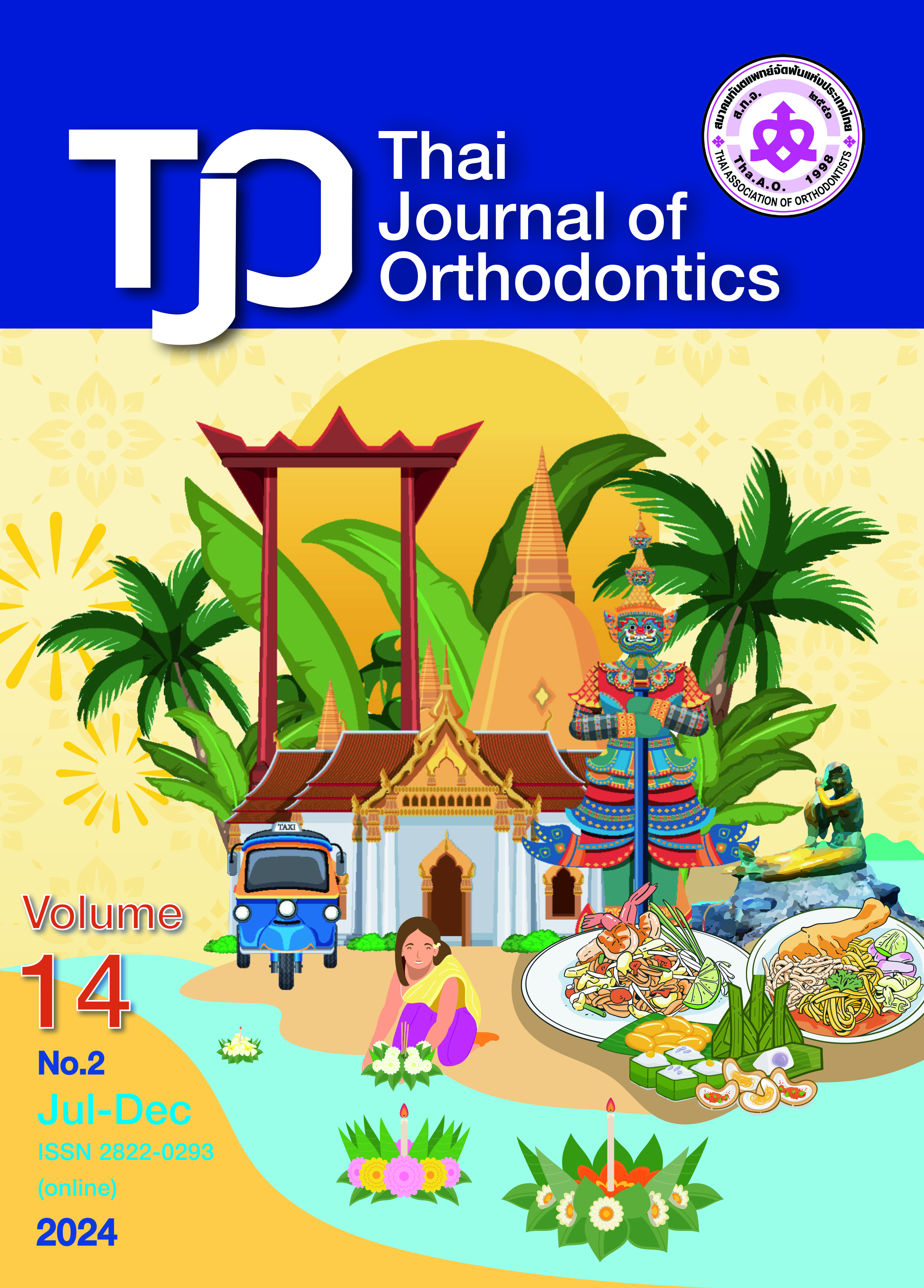Correction of Severe Skeletal Class II Discrepancy with Orthodontic Treatment Combined with Bimaxillary Orthognathic Surgery: A Case Report
Main Article Content
Abstract
Background: A 53-year-old Thai female patient came to the orthodontic clinic with upper anterior teeth protrusion and insecurity while smiling as the chief complaints. Her expectation was to correct these problems. The examination showed severe skeletal Class II discrepancy with hyperdivergent facial pattern, orthognathic maxilla but retrognathic mandible, and anterior gummy smile. An orthodontic treatment combined with bimaxillary orthognathic surgery was planned. The treatment objectives were to correct the upper anterior teeth protrusion and gummy smile and improve the patient’s skeletal, dental, and soft tissue morphology. The treatment duration was 34 months to achieve normal skeletal, dental, and soft tissue structure in the anteroposterior, vertical, and transverse dimensions. At 30 months after completing treatment, the patient was recalled. We found acceptable function, improved esthetic results, and stability. The patient was pleased with the treatment outcome.
Article Details

This work is licensed under a Creative Commons Attribution-NonCommercial-NoDerivatives 4.0 International License.
References
Kiekens RM, Maltha JC, Hof MA, Kuijpers-Jagtman AM. Objective measures as indicators for facial esthetics in white adolescents. Angle Orthod 2006;76(4):551-6.
De Ridder L, Aleksieva A, Willems G, Declerck D, Cadenas De Llano-Pérula M. Prevalence of orthodontic malocclusions in healthy children and adolescents: a systematic review. Int J Environ Res Public Health 2022;19(12):7446.
Tehranchi A, Behnia H, Younessian F, Hadadpour S. Advances in management of Class II malocclusions. In: Motamedi MHK, editor. A textbook of advanced oral and maxillofacial surgery. Rijeka: Intech; 2016.p.20.
Bishara SE. Class II malocclusions: diagnostic and clinical considerations with and without treatment. Semin Orthod 2006;12(1):11-24.
Dym H, Pierre R. Diagnosis and treatment approaches to a “gummy smile”. Dent Clin North Am 2020;64(2):341-9.
Pongsupot S, Suntornlohanakul S. Comparison of Class II malocclusion characteristics. Thai J Orthod 2020;8(2):25-32.
Arnett GW, Gunson MJ. Facial planning for orthodontists and oral surgeons. Am J Orthod Dentofacial Orthop 2004;126(3):290-5.
Basciftci FA, Usumez S. Effects of extraction and nonextraction treatment on Class I and Class II subjects. Angle Orthod 2003;73(1):36-42.
Demir A, Uysal T, Sari Z, Basciftci FA. Effects of camouflage treatment on dentofacial structures in Class II division 1 mandibular retrognathic patients. Eur J Orthod 2005;27(5):524-31.
Khechoyan DY. Orthognathic surgery: general considerations. Semin Plast Surg 2013;27(3):133-6.
Al-Moraissi EA, Wolford LM, Perez D, Laskin DM, Ellis E. Does orthognathic surgery cause or cure temporomandibular disorders? a systematic review and meta-analysis. J Oral Maxillofac Surg 2017;75(9):1835-47.
Chintawongvanich J, Thongudomporn U. Arch dimension and tooth size in Class I malocclusion patients with anterior crossbite. J Dent Assoc Thai 2013;63(1):31-8.
Sisman Y, Ertas ET, Ertas H, Sekerci AE. The frequency and distribution of idiopathic osteosclerosis of the jaw. Eur J Dent 2011;5(4):409-14.
Sorathesn K. Craniofacial norm for Thai in combined orthodontic surgical procedure. J Dent Assoc Thai 1988;38(5):190-201.
Suchato W, Chaiwat J. Cephalometric evaluation of the dentofacial complex of Thai adults. J Dent Assoc Thai 1984;34(5):233-43.
Dachkunakron S. Thai adult norms in various lateral cephalometric analyses. J Dent Assoc Thai 1994;44(5):202-14.
Rinchuse DJ, Miles PG, Sheridan JJ. Orthodontic retention and stability: a clinical perspective. J Clin Orthod 2007;41(3):125-32.
Schott TC, Schlipf C, Glasl B, Schwarzer CL, Weber J, Ludwig B. Quantification of patient compliance with hawley retainers and removable functional appliances during the retention phase. Am J Orthod Dentofacial Orthop 2013;144(4):533-40.
Proffit WR, Fields HW, Larson B, Sarver DM. Contemporary orthodontics. 6th ed. Philadelphia: Elsevier; 2018.p.664-7.
Bousaba S, Siciliano S, Delatte M, Faes J, Reychler H. Indications for orthognathic surgery, the limitations of orthodontics and of surgery. Rev Belge Med Dent (1984) 2002;57(1):9-23.
Kim YK. Complications associated with orthognathic surgery. J Korean Assoc Oral Maxillofac Surg 2017;43(1):3-15.
Broers DLM, van der Heijden G, Rozema FR, de Jongh A. Do patients benefit from orthognathic surgery? a systematic review on the effects of elective orthognathic surgery on psychosocial functioning and patient satisfaction. Eur J Oral Sci 2017;125(6):411-8.
Al-Moghrabi D, Barber S, Fleming PS. Removable retention: enhancing adherence and the remit of shared decisionmaking. Br Dent J 2021;230(11):765-9.
Kartal Y, Kaya B. Fixed orthodontic retainers: a review. Turk J Orthod 2019;32(2):110-4.
Mollov ND, Lindauer SJ, Best AM, Shroff B, Tufekci E. Patient attitudes toward retention and perceptions of treatment success. Angle Orthod 2010;80(4):468-73.


